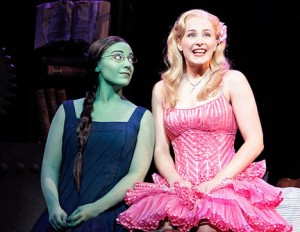If you know about popular…
A few years ago, I was putting on a little devised music theatre piece with a friend of mine for some primary school children. She suggested that, among the various well-known songs that we might include, a prime candidate was ‘Popular’ from the show Wicked. It’s a great song, catchy and witty, and it went down a storm with our audience (as did my friend’s pointy black hat and wand). Here’s a little section of the lyrics:
When I see depressing creatures
With unprepossessing features
I remind them on their own behalf
To think of
Celebrated heads of state or
Specially great communicators
Did they have brains or knowledge?
Don’t make me laugh! Ha, ha!
They were popular! Please –
It’s all about popular!
It’s not about aptitude
It’s the way you’re viewed
So it’s very shrewd to be
Very very popular
Like me!
You might think that researching a chapter on nineteenth-century Lied composers at the British Library was a pretty weird activity to bring to mind a song about witches with media presence… but this is exactly what happened to me this summer. There I was, working through texts on a series of lesser-known composers and singers; and at the bottom of the pile was a book about a particularly successful and extraordinary female performer and composer about whom I knew relatively little, and wanted to learn more. Surprisingly, given her international profile and impressive list of musical friends, there is a dearth of decent published information her; so I had selected one of the few recent books about her to get a sense of the fine details of her career.
The biographer made it quite explicit in his preface that this was a book intended for the general reader. He was not going to assume music-theoretical knowledge, would provide all due historical context, and so on. In other words, this was written as popular history. Given the number of rather tough tomes I’d had to wade through already, it was quite a relief to pick it up and read this assurance that it would not be a hard slog, and that it would be entertaining and informative. Good, I thought. Sounds ideal.
Except that I found it utterly, infuriatingly unreadable. It was journalistic slap-dash writing of the worst kind – chopping and changing between narratives, dwelling on lurid sensationalist events that distorted the sense of direction of each chapter, and using language so loaded that it was patently, and apparently delightedly, chauvinist. Oh yes, and all the women were referred to by the first names, whilst the men got the surname treatment (see one of my previous posts for more on that). I contained my rage sufficiently to make it through about 50 pages, and then had to stop reading it. I looked elsewhere to find the information I needed, to ‘formal’ academic sources, often harder work to read, but which just told me what I needed to know.
Popular history is a wonderfully powerful genre – some of the most compelling and informative non-fiction I’ve read has been published with an eye to this market, and it is often meticulously researched and beautifully written. There is also nothing wrong with drawing upon the most effective aspects of a journalistic approach to provide pithy, memorable forms of presenting dense information, or guiding you through a mass of conflicting evidence. Writers like Alex Ross, Graham Robb, Robert Winston and others have done extraordinary things to enhance the public understanding of complex or obscure subjects.
But being ‘popular’ does not, as Galinda seems to think in Wicked, exclude the possibility of a person also having brains, knowledge, or good communication skills. Indeed, tremendous ingenuity and creativity is often required to translate specialist research into a form that is digestible to those of us without multiple PhDs in the area (as beautifully demonstrated by Alexander Rehding and Elizabeth Eva Leach at the Royal Musical Association‘s annual conference last week). It requires a thorough understanding of both your subject, and your audience – and the ability to empathise with that audience in a way that takes account of their likely levels of awareness of a given topic, and how they might relate to it. Look at Kenneth Clarke and his celebrated series Civilisation (the focus of a wonderful recent exhibition at Tate Britain). Or Simon Schama; David Attenborough; the Freakonomics team; Brian Cox… the list goes on and on. And let’s not forget the hard-working and often visionary teams responsible for running our national collections at the Science Museum, Natural History Museum, V&A, galleries and libraries, who are constantly seeking new ways to engage non-specialists with new information and ideas.
What is the moral of this story? I’m not about to turn this blog into a series of vituperative book reviews, and I realise that different approaches suit different people. But for my money, the best kind of popular, in this instance, is a storyteller who can sketch in finest detail all the brilliant and unique things about a subject or a person in vivid colours, even if those colours – or the style of artwork, or even the canvas – were unknown to you when you first started reading. As for the caricaturists who insist in working only in day-glo, thick-tipped felt pens: watch out. Those colours are going to go out of fashion pretty soon, and then people might just start noticing that actually… you can’t really draw.
